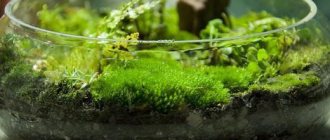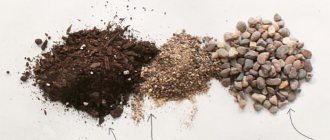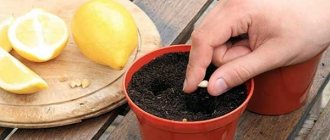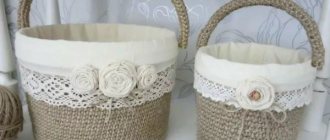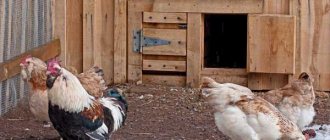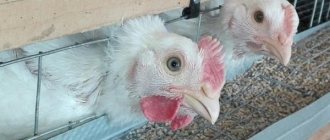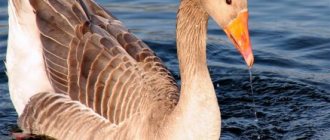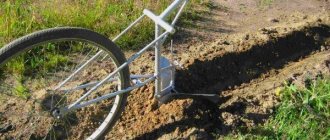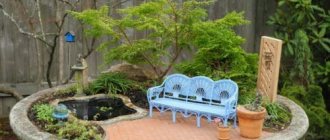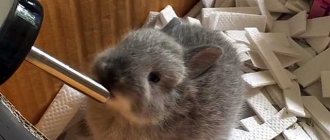Definition and purpose of the device
An aerator is a mechanical installation that saturates the water of a decorative outdoor pool with oxygen. Mollusks, fish, snails and other organisms living in a body of water require a specific concentration of oxygen to maintain their life processes. Its lack negatively affects the condition of all living things. In nature, water exchange occurs continuously. All rivers, oceans, groundwater are connected, and the atmosphere and precipitation also participate in the movement process. However, private open water bodies are not included in the total turnover. Their bottom is usually lined with insulating material, so the small surface of the pool is not able to provide oxygen to the entire water column. As a result, the pond becomes lifeless, and then becomes covered with malicious algae and rot.
An aerator will help turn stagnant, mud-filled ponds into beautiful decorative ponds filled with life. In addition, the aeration process helps purify the water. The dirt, having begun to interact with oxygen, collects in sediment or accumulates near the coast in the form of foam.
Equipment for the procedure
Experts distinguish between devices with a motor and mechanical aerators.
Mechanical structures are divided, in turn, into:
- sandal aerators;
- roller units;
- rake-aerators.
Rake-shaped structures are made on the basis of narrow plates. During operation, they cultivate the soil, while maintaining the integrity of lawn plantings.
Roller devices are made in the form of a rake, only they are equipped with rollers, which provides additional comfort during the work process.
Sandal aerators are distinguished by their shape, which resembles a sole. It is attached to the legs using straps. Its lower part is equipped with protrusions and spikes. You should work with such devices as follows: you need to attach the sandals to your feet and just walk on the lawn.
Such lawn aerators are intended for small areas, since it is difficult to treat large areas in a similar way.
Rotary aerators, which are equipped with a motor, are multifunctional. In addition to piercing the ground and saturating it with oxygen, such devices eliminate various types of debris and dead grass.
There is also a distinction between aerators based on engine type. According to this criterion we can distinguish:
- gasoline;
- electrical devices.
Any of these types carries both advantages and disadvantages. The device with an electric motor is characterized by quiet operation and low weight. This aerator is very convenient to work with. But at the same time, it can be used to process only small areas, since the device receives power from the electrical network and its movement is limited by the cord.
A gasoline engine device is more suitable for processing large areas. But it also has its drawback - it can only be refueled with high-quality fuel. Otherwise, the engine may be damaged.
Structure and types
Aerators (air compressors) are mechanical compression-type installations. Their main purpose is to enrich water with oxygen and create artificial flows for mixing water layers. In winter, the pond aerator creates a gulley. Through it, harmful gases escape to the surface and air enters. A typical system includes:
- compressor;
- air sprayers;
- connecting fittings;
- breeder;
- silicone hoses connecting the propagator to the compressor and sprayers;
- spring valves that prevent hoses from freezing in winter.
There may be some nuances in the structure - this depends on the principle of operation and the type (there are three of them) of installation.
Water aeration
Under natural conditions, where bodies of water flow into one another, the water becomes saturated with oxygen. Continuously flowing springs replenish water bodies with microelements. But ponds may require forced aeration. The need for this is due to a number of circumstances:
- Seasonal and daily temperature changes. The warmer the water, the faster the metabolism of flora and fauna occurs. This leads to greater oxygen consumption.
- Too much silt. This sediment interferes with normal oxygen exchange.
- Excess vegetation. If the pond is not cleaned in a timely manner, algae occupy a huge area and impede free gas exchange.
- Excessive number of inhabitants. The more representatives of the fauna, the more active the life activity and the more its products are released.
- Rare precipitation. Rainwater is also a source of minerals and can increase oxygen levels.
- The need to mix the layers of water so that stagnation does not occur.
- During aeration, the temperature regime is normalized.
To find out whether you really need to install an aerator in your case, it is enough to observe a little what is happening in the pond:
- If there is a fish, does it invariably rise to the surface in order to swallow the air space?
- Has a film appeared that indicates stagnation?
- Watch the snails. If they move freely on the stones, then everything is fine, if they are all on the seaweed and try to stand as high as possible, there is reason to worry.
Types and selection
Any pond, decorative or commercial, needs aeration. Of course, an industrial installation will require investment, and a DIY installation will require time. But the problems that arise in a stagnant reservoir are not comparable to the waste. There are various types of devices on sale.
- Superficial. These devices lift and release water in the form of a cascade or fountain jet. It looks beautiful in small decorative pools. The work is based on the fact that the pump takes in a certain amount of water and expels it with acceleration. The jets, being at the top, are saturated with oxygen, then, falling, they make up for its lack in the reservoir.
- Ejector. The units are equipped with blades, which are driven by a built-in motor. They hit the water, it mixes, and air bubbles form.
- Combined. Such an aerator is placed on the shore, the sprayer is in the water, and the head is on top. A stream of water flows from it like a fountain, which, as it falls, enriches the water with oxygen.
- Wind. This is an autonomous compressor, and it does not require a source of electricity to operate; wind power is sufficient. The device consists of an underwater propeller and wings located above the water. The wind rotates the wings, and they transmit impulse to the propellers, which begin to mix the water.
- Bottom. A relatively new, but highly effective type of pond aerator. The apparatus itself is installed at the edge or away from the pool, and only the diffuser and tubes are lowered into the water. A certain amount of water passes through small holes, as if “piercing” its main thickness. This way the water layers are continuously mixed, and the pond is saturated with oxygen. It is convenient that the noise of the installation will not disturb the inhabitants of the reservoir and the owners if the pool is located close to the house. The aerator can be placed on the other side or hidden in a building.
The choice of compressor depends on the size, depth and population of the pool. So, for a small summer cottage pond with water lilies, the simplest surface device is suitable, and if the reservoir is intended for economic fish breeding, a bottom device is suitable.
On a note!
Surface, combined and ejector compresses create constant noise, which can disturb pond residents. This must be taken into account when choosing a device.
Types of aerators
Bottom aerator with compressor on the shore
Before you make your own air spray for a pond, you need to decide on its type. There are 4 design options.
- Surface - used very often in decorative ponds, as they often imitate fountains and waterfalls. The pump draws water from the pool and throws it forcefully into the air. The water is saturated with oxygen and immediately returns to the pool. It is not recommended to install such a device in a pond with fish, as the installation creates quite a lot of noise.
- Ejector – the working element of the device is a wheel with blades. Rotating, the blades lift water into the air, it is saturated with oxygen and returns to the reservoir. The device effectively mixes the lower and upper layers of water, has high power, but creates no less noise.
- Bottom - the compressor is placed on the shore, and a supply pipe with a diffuser is lowered to the bottom of the pond. The air is supplied directly into the water column and distributed evenly. The most effective option for a fish pond, as it does not harm the inhabitants and does not frighten them with noise.
- Combined - the compressor of the device is installed on the shore, the pipe with the sprayer is placed on the surface. This creates a fountain effect and oxygen saturation occurs faster.
All models run on electricity.
The wind aerator is an axle. Large blades are installed above the level of the reservoir, and smaller blades or a propeller are installed under water. The wind causes the windmill to spin, the movement is transmitted along the shaft to the screws, and they mix the water flows. This aeration option works autonomously.
Features of winter installations
It is necessary that the aeration process takes place year-round. Otherwise, in cold weather, an ice crust will form on the surface of the pool, which will prevent air from entering the water. This will lead to the death of plankton, fish and flora. In addition, if pond aeration is not carried out in cold weather, a stagnant winter pond will most likely freeze through. Therefore, you need to take care of the condition of the reservoir even before the onset of frosty months.
An aerator for a pond in winter should be able to withstand strong temperature drops and have sufficient power. It should be noted that even a frost-resistant device has an acceptable temperature limit. You need to focus on it when choosing an installation for a particular region. Wind filters and bottom filters for ponds are suitable for winter use.
The need to install an aerator
An aerator is needed for a pond where fish are raised.
You need to create pond aeration with your own hands if the following symptoms are observed:
- the fish grows poorly, moves little, floats up;
- ornamental plants develop poorly;
- blue-green algae multiply;
- the water stagnates, gives off an unpleasant odor, and blooms.
The problem can be solved by changing the water more frequently if there are no fish living in the pond. However, in most cases it is cheaper to install and use an aerator.
Factory models
There are various models of compressors available for sale. They can be chosen for a pool of any size. The price of the unit depends on the power and type. So, for a summer miniature garden pond you can buy a device within 10 thousand rubles. A medium-sized pool will require the installation of an aerator costing 40-70 thousand; for a large fish pond, installation will cost at least 100 thousand. The following brands are popular:
- Pontec (Germany). Pond aerator compressors from this company are distinguished by their well-thought-out design, minimal noise level, and ease of use. The devices can be used both in indoor and outdoor pools. Can serve reservoirs up to 1000 m³. Depending on the model, the installations generate power from 15 to 30 W. Each device comes with a 10 m long cable. Wear-resistant materials and composite raw materials are used in manufacturing.
- Robust Air Rae-1. A bottom-type installation will provide oxygen to a pond with an area of up to 4000 m². The sprayer can be deepened to 6.9 m. Can be used at any time of the year. Economical, reliable, and of good quality.
- ACO compressors and aerators for Jebo pond. The units are of high quality, safe and easy to operate and maintain. Suitable for small garden ponds. Most models are suitable for ponds up to 300 m³. Well maintains the required level of oxygen in the pond, prevents flowering and silting of water.
- Air Flow 25F. Floating type compressor. Creates a powerful, oxygenated water flow (direction can be changed). Used in fresh and sea water. Suitable for small and medium-sized pools, with a minimum depth of 0.65 m.
Important!
When choosing a power setting, you should add a small margin to the minimum. Otherwise, the device will wear out, which will shorten its service life.
Any models are supplied with instructions, most of them in the language of the country where the installation was made. Therefore, you need to take care of the translation in advance.
Devices for ponds
All special devices for the pond should be used as rationally as possible. The devices must fully comply with all functions and not spoil the overall appearance of the pond. It is necessary to select the optimal number of devices, and also calculate the total power indicator for each unit. For example, to maintain high-quality plastic reservoirs, you do not need to use too much equipment. An excessive amount of special equipment can result in increased costs of maintenance and significantly complicate the care of the reservoir.
We must not forget about the safety margin. If initially there is no question of caring for the fish in the pond, but over time the owner wants to start growing and breeding them, then such durability will help avoid replacing equipment in the future.
In decorative reservoirs it is necessary to install:
- filters for cleaning;
- special pumps;
- decorative lighting;
- skimmer (equipment for collecting debris and contaminants on the surface of the water);
- special ultraviolet lamps to eliminate all pathogens and harmful substances.
The choice of a specific device will depend on the purpose of the pond and its needs for individual components. There is no need to install such a device in a body of water that is offered by industry. A small pond with healthy and abundant vegetation can independently provide itself with the required amount of substances and maintain its normal state. Others may only use filters.
For decorative ponds, cascades, and fountains, you need to use special pumps. They are considered particularly reliable and airtight.
Modern models of pumps (pumps) are a combination of high power and achievements in technological progress. They are completely silent during operation and can lift water to great heights. The devices can be installed both on the surface and in the water itself. The choice of a specific model will depend on the characteristics of the use of the reservoir. For fish, it will be necessary to use additional equipment.
Is it possible to do it yourself
Industrial aerators are reliable, durable, but quite expensive. The purchase of a factory device is the most significant expense item when organizing an artificial reservoir. However, you can make a pond aerator yourself and save a lot. Of course, you will need the ability to work with tools and equipment.
Assembling the ejector installation
You may be interested in: Ticks in the Moscow region and Moscow in 2021: the most dangerous areas How to order turnkey roofing installation How to find out the current prices for soybeans
First you need to buy materials for work:
- drainage pump;
- corners and corner tees at an angle of 45°;
- metal-plastic or PVC pipe of the required length;
- pipe 40-60 cm;
- double insulated wire.
The pump can be of medium power, taking into account the area of the pond. The wire cross-section must withstand the voltage during continuous operation.
Assembly algorithm:
- Typically the pump is sold complete with a bushing and an elbow. First, insert the sealing material into the tee, then connect it to the sleeve. Seal the joints, for example, with silicone glue.
- Connect the pipe to the tee on the other side.
- Place a 45° angle in the upper outlet and attach a tube to it.
- Connect the resulting device to the angle adapter of the pump.
- Connect the electrical wire (if there are plugs, cut it off), hide it in the coupling and fill it with polymer.
- Place the pump at a depth of approximately 80-110 cm. The intake pipe should be on the surface of the pond. To do this, make a pole from a steel pipe, driving it into the ground.
- It is recommended to place the pump in a mesh container. Attach the balloon to the pole, supply energy.
Important!
You cannot use a tee with an angle of 90°, as in this case air may flow back.
Assembling the bottom installation
Assembling the device is easy. You need to stock up on a compressor from your car. You also need to buy tee couplings and clamps. Sprayers are commercially available, but they can be made from any plastic cans or bottles. Assembly algorithm:
- Install the compressor on the shore or in an existing building nearby.
- Connect a hose to it and stretch it to the pond.
- Make bends using tees. Their number should be equal to the number of nozzles. Connections can be strengthened with staples.
- Attach the diffusers to the tees and lower them to the bottom. To prevent the diffusers from floating up (otherwise you will end up with fountains), you can use embedded pipes and embedded fittings. You can simply press down the diffusers with bricks.
These devices cannot function continuously. It is recommended to use these devices for periodic enrichment of water.
Principle of operation
In the natural environment, the enrichment of water bodies with the oxygen element is achieved through water circulation. Moisture evaporates from the surface of the reservoir, springs gush from the bottom, and the water areas are replenished by streams, tides or rainwater.
In an artificially created reservoir with sealed walls, movement and natural renewal of water do not occur. Stagnation at the facility in winter, when there is a thick layer of ice on the surface of the pond, has a particularly detrimental effect.
Installation selection criteria
Each compressor is designed for a certain volume of water. For the inhabitants of a reservoir, excess oxygen is as harmful as its lack. It is necessary to take into account the need for oxygen in different climatic periods of the year.
If you need to choose a good quality air compressor, give preference to a German manufacturer. The price of a pond aerator depends on many indicators:
- air compressor power;
- Possibility of use at different temperatures;
- unit noise;
- manufacturer's reputation.
Summer aerators for small decorative ponds can be purchased at a price of 4-10 thousand rubles. For medium-sized artificial reservoirs, prices for pond aerators start at 40 thousand rubles. Stocked large ponds with winter air supply from well-known manufacturers cost over 100 thousand.
For example, the OASE Aqua-Oxy CWS 2000 pond aerator is suitable for supplying oxygen to 20 cubic meters of water. The installation costs 12 thousand, and comes complete with a motor with two aeration nozzles and hoses 2 and 5 meters long. The installation consumes only 250 W, low noise. The length of the wiring from the source to the outlet is 120 meters. The energy part can be located on the shore and even below the level of the pond, since a check valve is provided in the line. The set includes two decorative stones, stylized as tussocks with grass.
